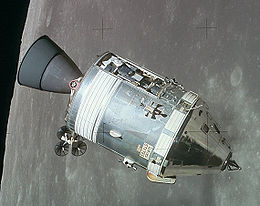 Apollo CSM Endeavour in lunar orbit during Apollo 15 | |||
| Manufacturer | North American Aviation | ||
|---|---|---|---|
| Designer | Maxime Faget | ||
| Country of origin | United States | ||
| Operator | NASA | ||
| Applications | Crewed cislunar flight and lunar orbit Skylab crew shuttle Apollo–Soyuz Test Project | ||
| Specifications | |||
| Spacecraft type | Capsule | ||
| Launch mass | 32,390 lb (14,690 kg) Earth orbit 63,500 lb (28,800 kg) Lunar | ||
| Dry mass | 26,300 lb (11,900 kg) | ||
| Payload capacity | 2,320 lb (1,050 kg) | ||
| Crew capacity | 3 | ||
| Volume | 218 cu ft (6.2 m3) | ||
| Power | 3 × 1.4 kW, 30 V DC fuel cells | ||
| Batteries | 3 × 40 ampere-hour silver-oxide | ||
| Regime | Low Earth orbit Cislunar space Lunar orbit | ||
| Design life | 14 days | ||
| Dimensions | |||
| Length | 36.2 ft (11.0 m) | ||
| Diameter | 12.8 ft (3.9 m) | ||
| Production | |||
| Status | Retired | ||
| Built | 35 | ||
| Launched | 19 | ||
| Operational | 19 | ||
| Failed | 2 | ||
| Lost | 1 | ||
| Maiden launch | February 26, 1966 (AS-201) | ||
| Last launch | July 15, 1975 (Apollo–Soyuz) | ||
| Last retirement | July 24, 1975 | ||
| Service Propulsion System | |||
| Powered by | 1 × AJ10-137[1] | ||
| Maximum thrust | 91.19 kN (20,500 lbf) | ||
| Specific impulse | 314.5 s (3.084 km/s) | ||
| Burn time | 750 s | ||
| Propellant | N2O4/Aerozine 50 | ||
| Related spacecraft | |||
| Flown with | Apollo Lunar Module | ||
| Configuration | |||
 Apollo Block II CSM diagram
| |||
The Apollo command and service module (CSM) was one of two principal components of the United States Apollo spacecraft, used for the Apollo program, which landed astronauts on the Moon between 1969 and 1972. The CSM functioned as a mother ship, which carried a crew of three astronauts and the second Apollo spacecraft, the Apollo Lunar Module, to lunar orbit, and brought the astronauts back to Earth. It consisted of two parts: the conical command module, a cabin that housed the crew and carried equipment needed for atmospheric reentry and splashdown; and the cylindrical service module which provided propulsion, electrical power and storage for various consumables required during a mission. An umbilical connection transferred power and consumables between the two modules. Just before reentry of the command module on the return home, the umbilical connection was severed and the service module was cast off and allowed to burn up in the atmosphere.
The CSM was developed and built for NASA by North American Aviation starting in November 1961. It was initially designed to land on the Moon atop a landing rocket stage and return all three astronauts on a direct-ascent mission, which would not use a separate lunar module, and thus had no provisions for docking with another spacecraft. This, plus other required design changes, led to the decision to design two versions of the CSM: Block I was to be used for uncrewed missions and a single crewed Earth orbit flight (Apollo 1), while the more advanced Block II was designed for use with the lunar module. The Apollo 1 flight was cancelled after a cabin fire killed the crew and destroyed their command module during a launch rehearsal test. Corrections of the problems which caused the fire were applied to the Block II spacecraft, which was used for all crewed spaceflights.
Nineteen CSMs were launched into space. Of these, nine flew humans to the Moon between 1968 and 1972, and another two performed crewed test flights in low Earth orbit, all as part of the Apollo program. Before these, another four CSMs had flown as uncrewed Apollo tests, of which two were suborbital flights and another two were orbital flights. Following the conclusion of the Apollo program and during 1973–1974, three CSMs ferried astronauts to the orbital Skylab space station. Finally in 1975, the last flown CSM docked with the Soviet craft Soyuz 19 as part of the international Apollo–Soyuz Test Project.
- ^ "Aerojet AJ10-137 Archives". December 25, 2022.